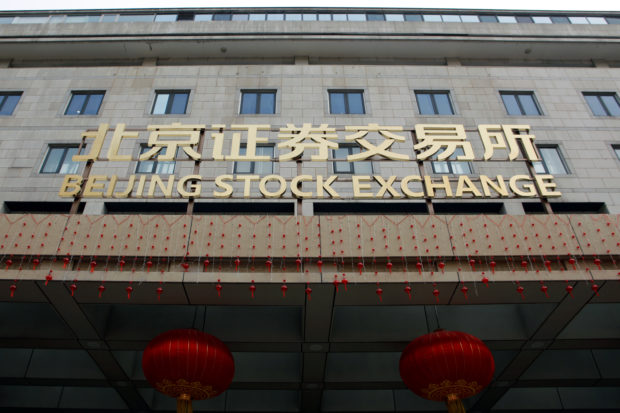
The sign of Beijing Stock Exchange is seen at its entrance during an organised media tour, in Beijing, China Feb 17, 2022. REUTERS/Florence Lo/File photo
HONG KONG/SINGAPORE -Foreign investors have barely begun buying back beaten-down stocks in China, but there are growing signs that the end of the country’s tough COVID-zero policy marks the beginning of a long global march back into Chinese equities.
December’s sudden shift from tight health restrictions to almost none at all by January has unleashed a wave of infections that have overwhelmed health officials and surprised financial markets, which had expected a slower transition.
MSCI China has gained a staggering 50 percent since November, when hopes of reopening first emerged, while Hong Kong’s Hang Seng Index is up 47 percent, against roughly 6 percent gains for world stocks.
But participation has been narrow, with brokers and analytics firms attributing most of the gains to short-covering and fast-money — leaving lots of room for flows from slower-moving institutional investors to drive the rally further.
Shifts in tones at big banks suggest they are warming up to Chinese equities, especially as the strong returns so far and the fear of missing out on more gains start to apply pressure.
“The economic and market effect of that reopening is just beginning to be felt,” said Ken Peng, head of Asia investment strategy at Citi Global Wealth Investments, who expects foreign inflows big enough to lift the yuan this year.
“This is still a long path and we remain very bullish on Chinese equities …and also the currency,” he said.
J.P. Morgan Asset Management is in the process of raising allocations to Chinese equities as the government’s dismantling of COVID restrictions puts the economy on a recovery path, while in developed markets like the United States, policies remain tight as central banks try to curb inflation, said Sylvia Sheng, global multi-asset strategist based in Hong Kong.
Then there is momentum.
“When the market goes up, naturally that will attract international investors to look at China again,” said Nicholas Yeo, head of China equities at abrdn.
Analysts with brokerage China International Capital Corp said short-interest in Hong Kong stocks dropped from about 24.5 percent in early October to 13.3 percent in late December, and that net outflows from overseas active funds showed they have not driven the recent rally – something it expects will reverse in the year ahead.
Global equity funds had around 1.8 percent allocated to China by the end of November, according to data provider EPFR, slightly up from the year’s low by end-October as market troughed, but significantly lower than the highest allocation recorded in April of 2015 at 3.1 percent. EPFR started tracking the numbers in 2001.
Foreign investors bought a net 41 billion yuan ($6.06 billion) of China stocks via the China-Hong Kong Stock Connect Scheme so far this year, compared with 90 billion yuan of China stocks bought in all of 2022. They bought a net 35 billion yuan of China stocks in December.
Unstoppable?
Improvement in sentiment has also been fuelled by broader signs of China shifting to a more relaxed regulatory environment, with new policies to support the battered property sector as well as a promised easing of its lengthy crackdown on tech companies, which had previously been favourites of foreign buyers.
“Our more bullish view is grounded by the first pro-growth alignment of Covid management, economic policy and regulatory policy in four years,” analysts at Morgan Stanley said in a note upgrading economic forecasts and stock price targets.
Laura Wang, chief China equity strategist with the firm, said foreign funds had been making some additions to large cap names including Alibaba Group Holding since last quarter.
If major institutional investors with underweight positions closed the gap with major stock benchmarks like MSCI and raised allocations to Chinese equities, that would lead to at least $29 billion of capital inflows, she estimated.
To be sure, there is caution, hesitancy and less consensus about when and where to invest than a few years ago when investors were piling in to China’s internet giants, she said.
Analysts warn the road to recovery is likely to be bumpy, with lingering COVID disruptions, a slow recovery in the property sector and worries over recessions in Europe and United States keeping investors on edge.
Short sellers have actually added to bets against U.S.-listed China shares in January, data from S3 Partners shows, and the gains in China’s onshore blue-chip benchmark have only carried it back to levels it hit on the way down in September.
The benchmark index is still more than 30 percent off the recent peak it touched in February 2021.
But the widely accepted view of a few short months ago, in October, that Xi Jinping’s new leadership team of loyalists signaled the sacrifice of growth for ideologically-driven policies, has been shaken by the abrupt u-turn on lockdowns.
“I think the reopening is happening for real, it is now basically unstoppable,” said Hugues Rialan, chief investment officer for Asia and head of discretionary portfolio management at Pictet Wealth Management.
Rialan said his firm was now slightly overweight Chinese equities, but would not add to positions presently and would rather wait for a dip, given the market has turned hot lately.
“We have international investors freaking out about China from time to time in the last 20 years,” said Jian Shi Cortesi, investment director at GAM Investment Management, citing the panic about the Chinese economy around 2008 and its currency around 2015.
“But eventually when the numbers come back and prove that the economy grows, corporate earnings grow, and that’s when investors will change views,” she said, expecting a bull market for China in the next two to three years.